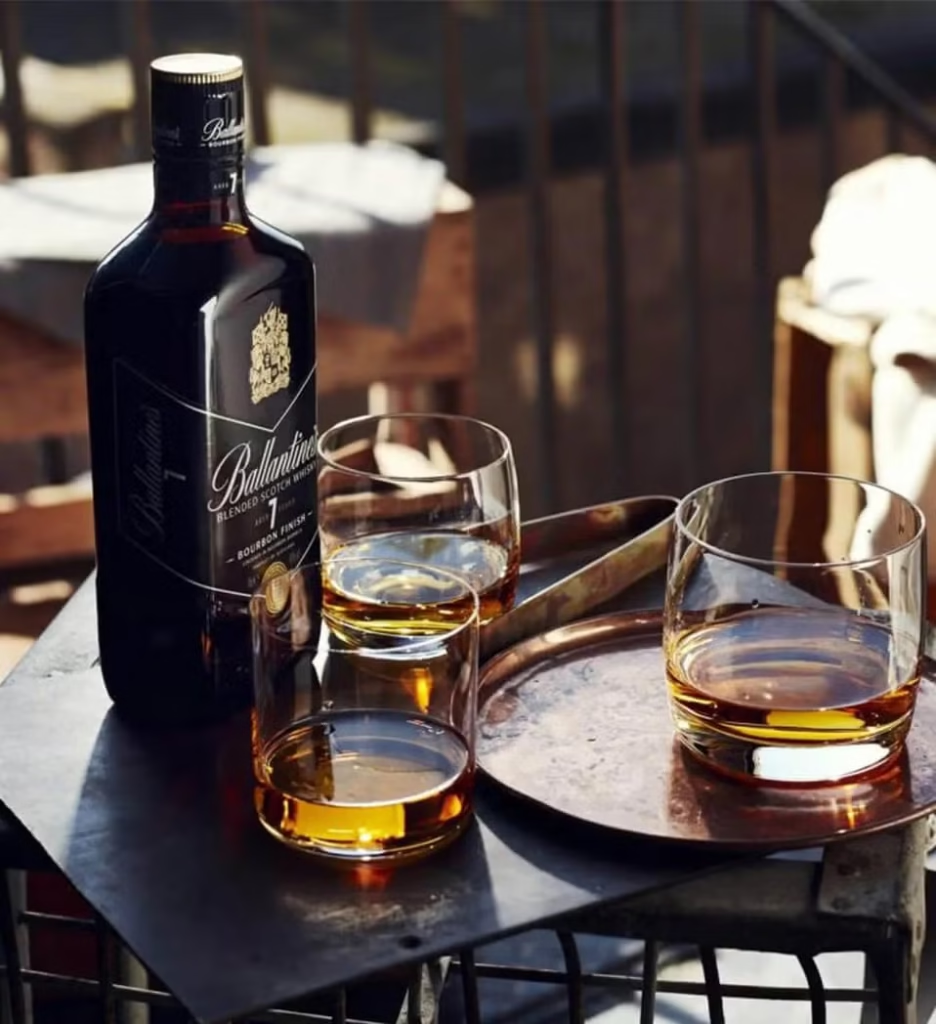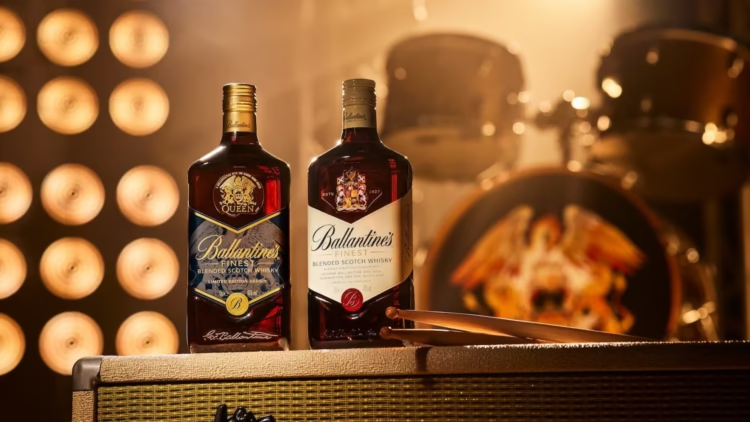Introduction
Ballantine’s is one of the oldest and most recognizable Scotch whisky brands, with a legacy stretching back to 1827. Today, it stands as a key player in the global whisky industry, offering a wide range of expressions that appeal to diverse consumer tastes. With a market presence in over 160 countries and an extensive portfolio of products, Ballantine’s has successfully navigated the challenges of a competitive global market.
This article will delve into the market dynamics surrounding Ballantine’s and explore its strategic positioning. By analyzing the brand’s approach to marketing, consumer engagement, and the competitive landscape, we will understand how Ballantine’s has maintained its prominent place in the whisky industry. We will also examine its differentiation strategies, growth trajectory, and future prospects.
Chapter 1: The Global Whisky Market – A Snapshot
- Market Overview
- The global whisky market is expansive and diverse, with Scotch whisky playing a pivotal role. Scotch whisky, particularly blended Scotch, accounts for a significant portion of the global whisky trade. Ballantine’s, as one of the most well-established Scotch whisky brands, plays a key role in shaping market trends and consumer preferences.
- Market Segments
- The whisky market can be broadly divided into several key segments: premium, luxury, and value whisky. Ballantine’s spans multiple price points, allowing it to cater to both mass-market consumers and those seeking premium or luxury products.
- Mass Market: Ballantine’s Finest and 12 Year Old cater to a broader consumer base looking for affordable quality whisky.
- Premium Market: The 17 Year Old and 21 Year Old target consumers who are willing to pay more for richer, more complex blends.
- Luxury Market: Limited-edition whiskies such as the 30 Year Old and special cask finishes are aimed at the high-end consumer looking for exclusive products.
Chapter 2: Brand Positioning – How Ballantine’s Sets Itself Apart
- Craftsmanship and Heritage
- Ballantine’s has positioned itself as a brand that balances heritage and craftsmanship with modern appeal. Its rich history dating back to 1827 is leveraged in its marketing as a symbol of trust, quality, and expertise in whisky blending.
- The brand’s tagline “In the Pursuit of Perfection” reflects its commitment to quality, blending expertise, and precision, which resonate with whisky connoisseurs around the world.
- Target Audience
- Ballantine’s targets a broad demographic, including whisky aficionados, collectors, and casual drinkers. The brand’s diverse range of expressions ensures that there is something for every type of consumer.
- The core audience is typically male, aged between 25 and 55, with a preference for quality spirits and an interest in the craft of whisky making. However, in recent years, Ballantine’s has also aimed to appeal to a younger audience, including women and emerging whisky drinkers in new markets.
- Premium Quality at Every Price Point
- Ballantine’s is known for maintaining high standards of quality at all levels of its product range. While offering accessible options like Ballantine’s Finest, the brand also produces ultra-premium expressions for connoisseurs.
- The brand has consistently invested in innovation, offering consumers a broader range of flavors, cask finishes, and limited-edition releases.
Chapter 3: Marketing and Brand Communication
- Global Marketing Strategy
- Ballantine’s employs an integrated marketing strategy that blends traditional advertising, experiential marketing, and digital outreach. Through impactful campaigns, the brand connects with consumers and creates a strong, memorable brand image.
- Traditional Advertising: In print, television, and outdoor campaigns, Ballantine’s showcases its core values of craftsmanship, quality, and heritage. Advertisements often evoke a sense of prestige and luxury.
- Experiential Marketing: Events such as tastings, masterclasses, and whisky festivals allow consumers to experience the brand firsthand and engage with the product on a deeper level.
- Digital Strategy: Ballantine’s has embraced digital marketing, with a strong presence on social media platforms like Instagram, Facebook, and Twitter. The brand’s digital content is often aspirational, promoting whisky tasting experiences and storytelling related to the heritage of the brand.
- Influencer and Celebrity Endorsements
- Ballantine’s has also partnered with high-profile influencers and celebrities to help elevate its brand image. Collaborations with famous figures from the worlds of music, sports, and entertainment serve to increase visibility and attract a younger audience.
- Packaging and Design
- Ballantine’s focuses on premium and sophisticated packaging that reinforces its image as a high-quality whisky. The sleek bottles, elegant labels, and refined design elements communicate both luxury and accessibility, ensuring that consumers feel they are purchasing a product of distinction.

Chapter 4: Ballantine’s Distribution and Global Presence
- Global Reach and Market Penetration
- Ballantine’s is present in over 160 countries, and its reach spans across key markets such as the United States, the United Kingdom, China, Japan, and many other emerging markets.
- The brand is well-established in Europe and Asia, where whisky consumption is growing, particularly in countries like China and India, where the demand for premium spirits is on the rise.
- Positioning in Key Markets
- In the United States, Ballantine’s holds a significant share of the blended Scotch whisky market. It competes directly with brands such as Johnnie Walker, Dewar’s, and Chivas Regal. Ballantine’s has positioned itself as an accessible yet high-quality option, suitable for both casual and more discerning whisky drinkers.
- In Asia, particularly China and Japan, the demand for premium Scotch is growing rapidly. Ballantine’s has targeted these emerging markets with tailored offerings and localized marketing campaigns to cater to the tastes of local consumers. Its emphasis on craftsmanship and quality resonates well with the Asian consumer, who values tradition and authenticity.
- Retail Strategy
- Ballantine’s is sold through multiple channels, including duty-free shops, luxury retailers, and supermarkets. The brand has effectively established a retail presence across both online and offline platforms.
- E-commerce: The rise of online retail has been significant for Ballantine’s, as consumers are increasingly turning to e-commerce platforms for premium spirits. The brand has optimized its online presence, offering direct sales through websites, digital promotions, and special releases.
Chapter 5: Competitive Landscape – Ballantine’s vs. The Competition
- Competitive Brands
- Ballantine’s operates in a highly competitive space with several strong contenders in the blended Scotch whisky market. Key competitors include brands like Johnnie Walker, Chivas Regal, Dewar’s, and Grant’s. While Johnnie Walker is the dominant player, Ballantine’s has carved out a space for itself by focusing on its rich heritage, masterful blending, and wide range of expressions.
- Brand Differentiation: Ballantine’s differentiates itself through its focus on premium quality, craftsmanship, and its ability to appeal to a broad audience. Unlike some competitors, it has been able to maintain a strong presence in both the mass-market and luxury segments.
- Emerging Trends in Whisky
- The whisky industry is seeing trends such as the growing demand for premium and aged expressions, single malts, and cask finishes. Ballantine’s has been quick to adapt to these trends by introducing expressions such as Ballantine’s 17 Year Old, Ballantine’s 30 Year Old, and limited-edition releases.
- Innovation and Product Development
- Ballantine’s is known for its innovations in the whisky market. Whether it is the introduction of new expressions or special cask finishes, the brand is continually refining its product offering to stay relevant in a competitive market.
Chapter 6: The Future of Ballantine’s – Opportunities and Challenges
- Opportunities
- Growth in Emerging Markets: As whisky consumption continues to grow in regions like Asia, Latin America, and Africa, Ballantine’s has significant opportunities for expansion.
- Premiumization Trend: Consumers are increasingly willing to spend more on premium and luxury whiskies. Ballantine’s can continue to leverage this trend by focusing on its aged expressions and limited-edition releases.
- Challenges
- Intense Competition: With numerous whisky brands vying for market share, maintaining differentiation is a challenge. Ballantine’s must continue to innovate and enhance its product offerings to stay ahead of competitors.
- Changing Consumer Preferences: As younger consumers look for new drinking experiences, Ballantine’s must adapt its marketing and product strategy to appeal to this generation without alienating its loyal customer base.
Conclusion
Ballantine’s has strategically positioned itself as a brand that blends heritage, craftsmanship, and quality with innovation and market adaptability. Its wide-ranging product offerings, from accessible blends like Ballantine’s Finest to ultra-premium expressions like the 30 Year Old, have allowed it to capture the attention of whisky enthusiasts across various price points.
The brand’s presence in over 160 countries, coupled with its smart marketing campaigns, robust distribution channels, and commitment to excellence, ensures that Ballantine’s will remain a formidable player in the global whisky market for years to come. By continuing to adapt to market trends, consumer preferences, and emerging markets, Ballantine’s is well-positioned for continued success in an ever-evolving industry.































